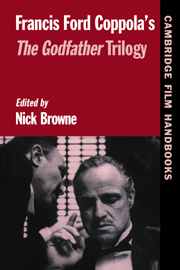Book contents
- Frontmatter
- Contents
- Acknowledgments
- List of Contributors
- Francis Ford Coppola's Godfather Trilogy
- Fearful A-Symmetries
- 1 If History Has Taught Us Anything … Francis Coppola, Paramount Studios, and The Godfather Parts I, II, and III
- 2 The Godfather and the Mythology of Mafia
- 3 The Representation of Ethnicity in The Godfather
- 4 Ideology and Genre in the Godfather Films
- 5 Family Ceremonies: or, Opera in The Godfather Trilogy
- Filmography
- Reviews of the “Godfather” Trilogy
- Select Bibliography
- Index
3 - The Representation of Ethnicity in The Godfather
Published online by Cambridge University Press: 05 June 2012
- Frontmatter
- Contents
- Acknowledgments
- List of Contributors
- Francis Ford Coppola's Godfather Trilogy
- Fearful A-Symmetries
- 1 If History Has Taught Us Anything … Francis Coppola, Paramount Studios, and The Godfather Parts I, II, and III
- 2 The Godfather and the Mythology of Mafia
- 3 The Representation of Ethnicity in The Godfather
- 4 Ideology and Genre in the Godfather Films
- 5 Family Ceremonies: or, Opera in The Godfather Trilogy
- Filmography
- Reviews of the “Godfather” Trilogy
- Select Bibliography
- Index
Summary
To an Italian-American, “compare” means “godfather.” … Traditionally, a godfather means an alter ego in place of a parent in time of need. The picture The Godfather has had the effect of changing the meaning. Henceforth, the term Godfather will be understood to mean a ruthless Italian killer.
(Patrick Gallo, Old Bread, New Wine)The way some people link every Italian to the Mafia in a half joking way does not bother me. Actually, the Mafia has always been considered glamorous. I don't know why people find bullies that glamorous, yet it seems to be an unending source of fascination to Americans. … Some things have reached a level of the classic.
(Frank Stella, artist, Growing Up Italian)In writing about their cultural experience, members of the Italian-American community often regret the way they are stereotypically linked with organized crime in the American imagination. And it is Francis Ford Coppola's immensely popular Godfather trilogy that is perceived as being most influential in securing this criminal image. Although some Italian Americans are deeply offended by the association, others, like Frank Stella, for example, seem to take a distance from it. Stella observes that the brutal image of the Mafia is also a marketable and glamorous one. Criti-cally speaking, however, the insight that the representation of crime is attractive is not new, nor is the fact that it has made for centuries of popular entertainment.
- Type
- Chapter
- Information
- Francis Ford Coppola's The Godfather Trilogy , pp. 76 - 108Publisher: Cambridge University PressPrint publication year: 1999
- 2
- Cited by

